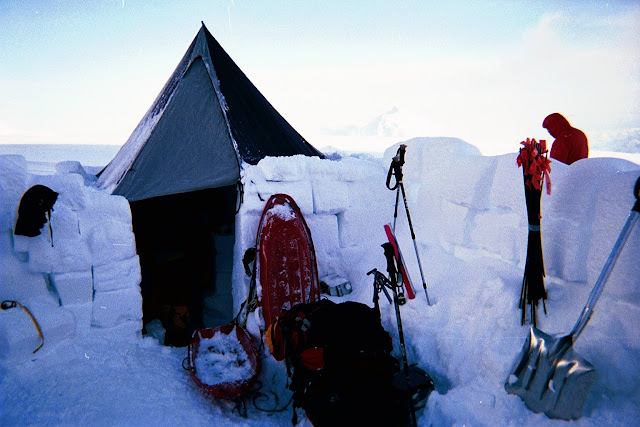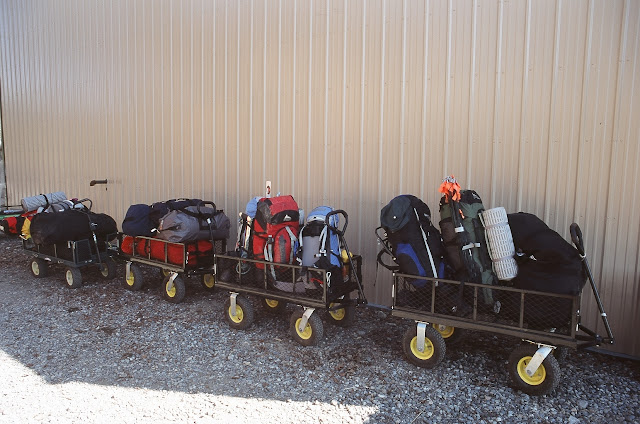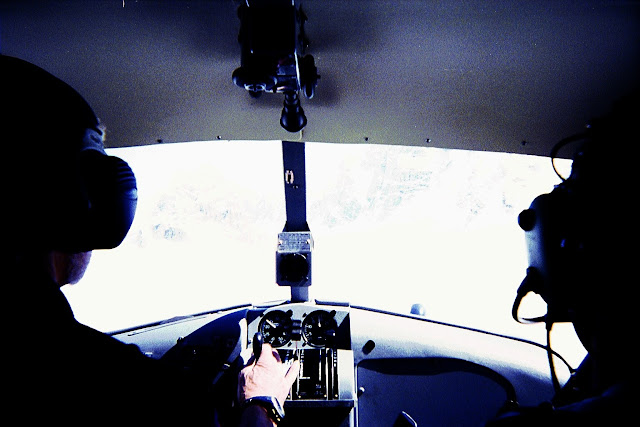Climbing the Denali Headwall
After a day of cloudy weather we had blue skies and no wind in the morning. Then everyone who planned a summit attempt stampeded to get their gear carried up to 16k or even go higher up to the 17k camp. The 2000+ foot climb gets to a 55 degree angle, is icy and has crevasses. This is one place where commercial guide outfits will install fixed ropes but everyone wants to use them, leading to major traffic jams. Using mechanical ascenders is necessary on these ropes
Looking back at the 14K camp
Heading up! The blues skies did not last long.
Weather is alreading getting bad.
Getting much steeper.
There were two sets of ropes; one for ascending and one for descending. On the uphill side we were held up by folks who were having various troubles getting up the ropes with their heavy loads. You can see that there were some morons who tried passing them by going up the rope that returning climbers needed to descend upon. This only made things worse and caused a traffic jam as the weather grew worse.
Up at 16K feet.
When we finally made it up we found a good spot to cache the extra fuel and food that would be our lifeline if weather at 17K became too bad for a summit attempt and also preventing us from descending to the 14K camp.
I really enjoyed going up the headwall despite all of the issues with the other climbers. I was feeling stronger and I was at a "highwater" (high ice?) mark in my climbing career at 2000 feet higher than anywhere I had been. Suddenly we were much closer to actually reaching the summit!
May 17th
We rested all day after the steep headwall climb and anxiously watched as the weather had turned worse. The radio forecasts were predicting a storm but on such a high mountain they could prove unreliable. We sought out Ranger Gordy and asked his advice. Gordy has been on the mountain for years and has the rare status of being a permanent climbing ranger. Most other rangers work on a seasonal as-needed basis.
Gordy looked at the cloudy sky, kicked the snow and thought for a moment. He asked if we had already cached at 16k and how we were feeling as a team. He then said that he felt that we would have a small window of opportunity before a big storm kicked in above 16k feet. He advised that the next morning we haul butt up to the high camp at 17k and get rested up. Then on the 19th get up and look for clear skies, wait for the sun to hit Denali Pass and raise the temps a bit and then go for the summit. He also advised us to not linger at 17k camp but get back down to 14k before the storm trapped us.
His advice was the road map to our success.
May 18th
Heading up the ridge route between the top of the headwall and the 17K camp.
This was the most spectacular climbing to date, both rugged and challenging. That big rock up ahead is called Washburn's Thumb, named for the man who pioneered modern climbing on the West Buttress route. That huge rock marks the halfway point to the 17k camp.
Sheer drops of 3000' or more are hidden by the clouds.
17 thousand foot camp! The Ice Rubes have arrived!
Here is a view of the camp's location and the route to the summit. The white arrows indicate potential avalanche zones.
This camp is a bleak outpost with ever thinner air, extreme temperatures and where every hard task takes more and more effort than the lower camps. We barely built protective walls, instead saving our energy for a 3000 foot climb to the summit. But look at those clear skies. A very good omen.
Our minimalist camp site. Those silver cannisters are the Clean Mountain Cans; heavy and bulky and we hauled them with us since the beginning. If you leave human waste up there the rangers will fine each person $100/day. Andy deployed his Himalayan prayer flags, anything worth giving us just a little more luck for a safe climb.
Denali Pass in the background, a daunting 1,000 feet higher than our lonely camp.
Our Dutch friends had run out of time and had to head down. I am on the left and Kerisi on the far right.
Will we summit the next day or will we head back down into the approaching storm?





















































